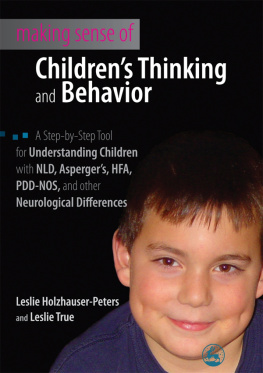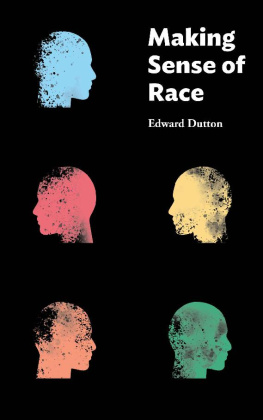Barondes - Making sense of people : the science of personality differences
Here you can read online Barondes - Making sense of people : the science of personality differences full text of the book (entire story) in english for free. Download pdf and epub, get meaning, cover and reviews about this ebook. City: Upper Saddle River, New Jersey, year: 2016, publisher: Pearson Education, genre: Religion. Description of the work, (preface) as well as reviews are available. Best literature library LitArk.com created for fans of good reading and offers a wide selection of genres:
Romance novel
Science fiction
Adventure
Detective
Science
History
Home and family
Prose
Art
Politics
Computer
Non-fiction
Religion
Business
Children
Humor
Choose a favorite category and find really read worthwhile books. Enjoy immersion in the world of imagination, feel the emotions of the characters or learn something new for yourself, make an fascinating discovery.

Making sense of people : the science of personality differences: summary, description and annotation
We offer to read an annotation, description, summary or preface (depends on what the author of the book "Making sense of people : the science of personality differences" wrote himself). If you haven't found the necessary information about the book — write in the comments, we will try to find it.
Barondes: author's other books
Who wrote Making sense of people : the science of personality differences? Find out the surname, the name of the author of the book and a list of all author's works by series.
Making sense of people : the science of personality differences — read online for free the complete book (whole text) full work
Below is the text of the book, divided by pages. System saving the place of the last page read, allows you to conveniently read the book "Making sense of people : the science of personality differences" online for free, without having to search again every time where you left off. Put a bookmark, and you can go to the page where you finished reading at any time.
Font size:
Interval:
Bookmark:
ePUB is an open, industry-standard format for eBooks. However, support of ePUB and its many features varies across reading devices and applications. Use your device or app settings to customize the presentation to your liking. Settings that you can customize often include font, font size, single or double column, landscape or portrait mode, and figures that you can click or tap to enlarge. For additional information about the settings and features on your reading device or app, visit the device manufacturers Web site.
Many titles include programming code or configuration examples. To optimize the presentation of these elements, view the eBook in single-column, landscape mode and adjust the font size to the smallest setting. In addition to presenting code and configurations in the reflowable text format, we have included images of the code that mimic the presentation found in the print book; therefore, where the reflowable format may compromise the presentation of the code listing, you will see a Click here to view code image link. Click the link to view the print-fidelity code image. To return to the previous page viewed, click the Back button on your device or app.
The Science of Personality Differences
Samuel Barondes
Second Edition
Publisher: Paul Boger
Editor-in-Chief: Amy Neidlinger
Executive Editor: Jeanne Glasser Levine
Cover Designer: Alan Clements
Managing Editor: Kristy Hart
Project Editor: Andy Beaster
Copy Editor: Language Logistics, LLC
Proofreader: Chuck Hutchinson
Indexer: Joy Lee
Compositor: Nonie Ratcliff
Manufacturing Buyer: Dan Uhrig
2016 by Pearson Education, Inc.
Published by Pearson Education, Inc.
Old Tappan, New Jersey 07675
For information about buying this title in bulk quantities, or for special sales opportunities (which may include electronic versions; custom cover designs; and content particular to your business, training goals, marketing focus, or branding interests), please contact our corporate sales department at or (800) 382-3419.
For government sales inquiries, please contact .
For questions about sales outside the U.S., please contact .
Company and product names mentioned herein are the trademarks or registered trademarks of their respective owners.
All rights reserved. No part of this book may be reproduced, in any form or by any means, without permission in writing from the publisher.
Printed in the United States of America
First Printing November 2015
ISBN-10: 0-13-421500-1
ISBN-13: 978-0-13-421500-6
Pearson Education LTD.
Pearson Education Australia PTY, Limited
Pearson Education Singapore, Pte. Ltd.
Pearson Education Asia, Ltd.
Pearson Education Canada, Ltd.
Pearson Educacin de Mexico, S.A. de C.V.
Pearson EducationJapan
Pearson Education Malaysia, Pte. Ltd.
Library of Congress Control Number: 2015948629
Also by Samuel Barondes
Cellular Dynamics of the Neuron
Neuronal Recognition
Molecules and Mental Illness
Mood Genes
Better Than Prozac
Before I Sleep: Poems for Children Who Think
For Louann
And for my grandchildren:
Jonah Lazar
Ellen Ariel
Asher Lucca
Every man is in certain respects
(a) like all other men,
(b) like some other men,
(c) like no other man.
Clyde Kluckhohn and Henry A. Murray
In 2001, after meeting Vladimir Putin for the first time, George W. Bush offered his famous impression of the Russians personality:
I looked the man in the eye. I found him to be very straightforward and trustworthy and we had a good dialogue. I was able to get a sense of his soul.
Bushs assessment of Putin as straightforward and trustworthy triggered various interpretations. Some took it at face value and were relieved that the two world leaders had hit it off. Others felt that Bush had been deceived by the ex-KGB man and were alarmed by his gullibility. Still others just dismissed it as the sort of polite statement politicians make to warm up their adversaries.
Years later Bush made clear he had meant what he said. When questioned directly by Hugh Hewitt during the 2010 book tour for his memoir, Decision Points, Bush explained it this way:
The reason why I said that is because I remembered him talking movingly about his mother and the cross she gave him that she had blessed in Jerusalem. Nobody knows that, and I never tried to make an explanation of why I said what I said until the book.
But Bush also saw a different side of Putin, which he revealed in a portrait he made after retiring from the presidency.contrast with his earlier assessment, the portrait does not depict Putin as being particularly trustworthy or straightforward. Instead the man Bush painted has been called pokerfaced and unreadable, scary and sinister, brimming with anger, contempt, and disgust.
How did Bush arrive at this darker view of the Russian leader? Was it based on his rethinking of Putins conduct on the world stage?
Although that would seem likely, the answer Bush gave was more personal: It had to do with Putins disdain for Bushs beloved dog Barney. On two occasions Putin had offended Bush by mocking Barneys weakness and small size and by comparing him unfavorably with his own dog, Koni. In response Bush apparently painted the face of Putin as the face of the man who had ridiculed his dear little friend. As Bush explained it in 2014 on the NBC Today Show:
Wow, anybody who thinks My dog is bigger than your dog is an interesting character. And the painting kind of reflects that.
The painting, of course, reflects more than an interesting character. The painting also reflects the difference between what Bush is comfortable expressing on canvas and what he is comfortable expressing in words.
George W. Bush is not alone. Many of us find it difficult to articulate our views of personalitiesnot only to others, but also to ourselves. Theres so much to consider, and its hard to convert what we know in our minds into a useful verbal picture.
Nevertheless, we can learn to do better. Making well-crafted portraits with words is just as teachable as making them with oils or pastels. In each case whats needed is good instruction and a dedicated student.
In the first edition of this book, I explained a step-by-step system for making better verbal portraits. It combined four ways of thinking about personalities based on decades of research by psychologists and psychiatrists. It showed how the information from these four perspectives could be put together into a rich and complex picture of each unique person.
Many readers found this helpful, but others had difficulty integrating the various parts. They wanted more practical assistance in applying it to the people in their lives. Put simply, they wanted more how to.
This new edition is designed with those people in mind. The only substantial change Ive made is to add a section, called Practical Summary, at the end of each chapter to discuss and illustrate applications. In these sections I also address misunderstandings and controversial points. The result Ive aimed for is not only more how to. Its also more heres why. At the end of the last chapter, I sum up the benefits of integrating information from all four perspectives into an overall portrait.
As a further aid to making the book more meaningful, I would like you to pick a significant person in your life (whom Ill call P) and keep him or her in mind as you go through the book. Repeatedly relating the material to this person may help you see what each perspective adds to the whole. To keep reminding you to do this, I will ask you to answer some relevant questions about P at the end of each Practical Summary.
Font size:
Interval:
Bookmark:
Similar books «Making sense of people : the science of personality differences»
Look at similar books to Making sense of people : the science of personality differences. We have selected literature similar in name and meaning in the hope of providing readers with more options to find new, interesting, not yet read works.
Discussion, reviews of the book Making sense of people : the science of personality differences and just readers' own opinions. Leave your comments, write what you think about the work, its meaning or the main characters. Specify what exactly you liked and what you didn't like, and why you think so.






